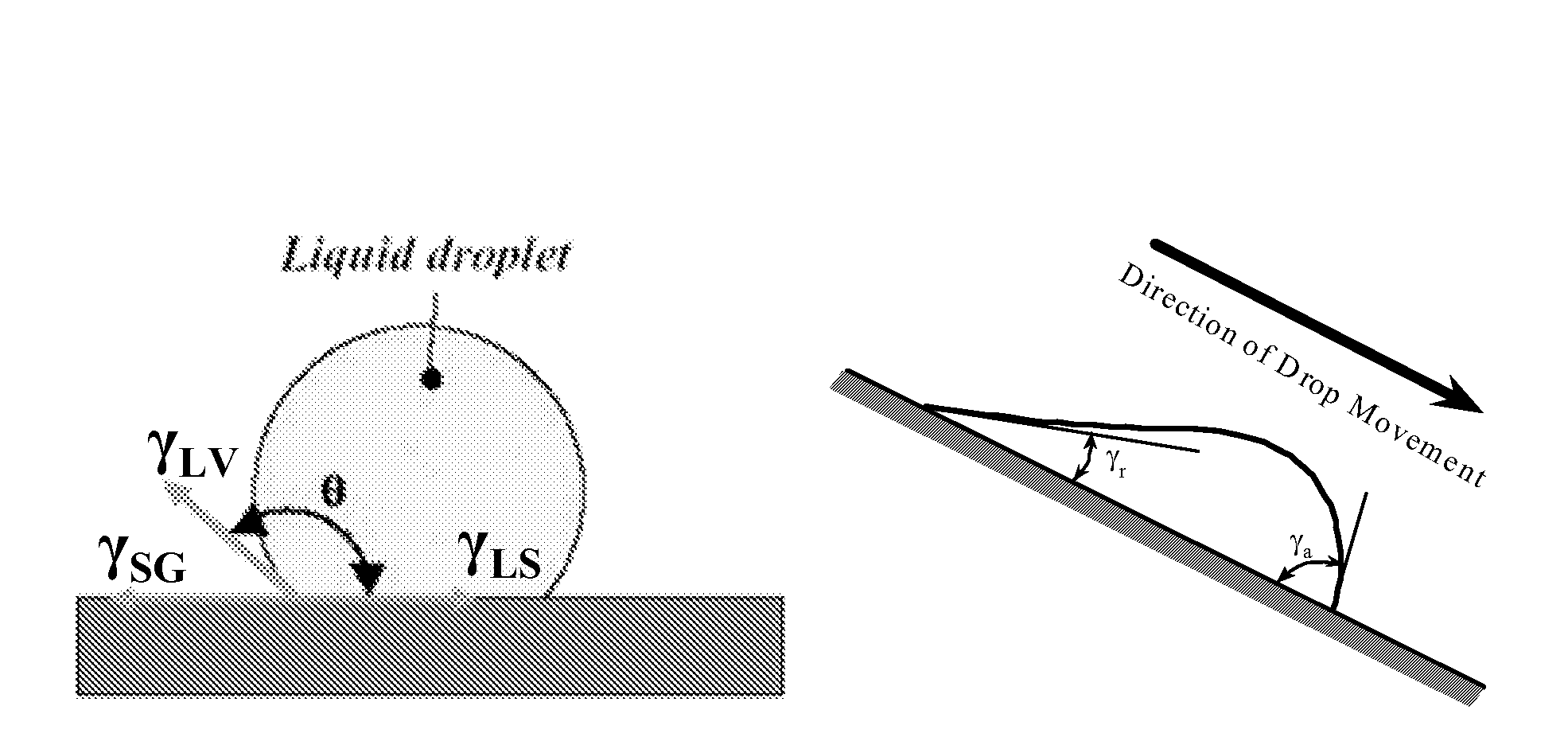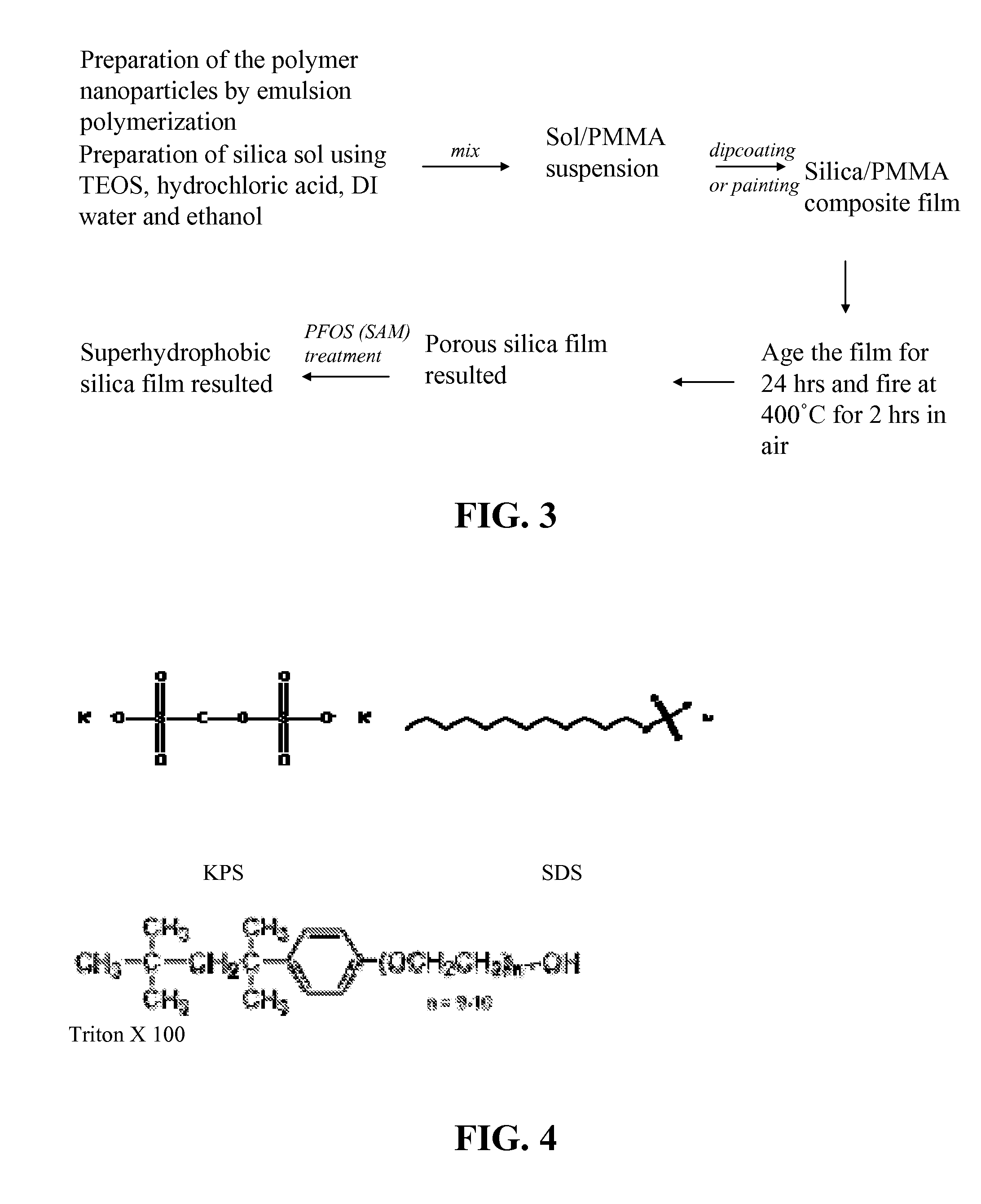Superhydrophobic surface and method for forming same
a superhydrophobic surface and coating technology, applied in the superimposed coating process, liquid/solution decomposition chemical coating, manufacturing tools, etc., can solve the problems of insulator contamination becoming a major impediment to the interruption of electrical power supply, increasing leakage current, and ultimately flashing, etc., to improve the superhydrophobic effect, improve the contact angle, and reduce the effect of hysteresis
- Summary
- Abstract
- Description
- Claims
- Application Information
AI Technical Summary
Benefits of technology
Problems solved by technology
Method used
Image
Examples
example i
Method Example I
[0217]TMOS (Precursor), IBTMOS (Coprecursor), and ethanol are first mixed together using the amounts given in TABLE 6 under “Material Example I.” HCl (0.1 M) is added to adjust the pH of the mixture to around 1.8-2.0. The reaction is started by heating to 60° C., and then holding for five (5) hours. After the reaction NH3H2O, 1.1M, a base, was added to the solution to initiate gelation of the polymer.
[0218]Before complete gelation, the solution may be cast onto a suitable substrate (microscope glass slide, elastomer, etc) to form a thin layer. The surface was covered to ensure slow evaporation of the ethanol and ammonia. After two (2) days, the film was completely gelled and the ethanol was completely evaporated. A thin silica layer was left on the substrate surface. Implementation on a glass microscope slide showed that the surface was superhydrophobic directly after coating due to the hydrophobic side chains present in IBTMOS coprecursor (FIGS. 18-19). TABLES 7-8 d...
example ii
Method Example II
[0222]TEOS (Precursor), TFPS (Coprecursor), and ethanol are first mixed together using the amounts given in TABLE 6 under “Material Example II.” HCl (1 M) is added to adjust the pH to around 1.8-2.0. The reaction was started by heating to 60° C., where the temperature was maintained for five (5) hours. After the reaction, 0.1 g ammonia hydroxide (29% wt) was added (1.1 M) to 2 g solution for gelation of the polymer.
[0223]Before complete gelation, the solution was cast onto a suitable substrate to form a thin layer. The surface was covered to ensure slow evaporation of the ethanol and ammonia. After two (2) days, the film was gelled and the ethanol was evaporated. A thin silica layer was left on the substrate, of which a suitable illustrative example is a glass microscope slide.
[0224]The surface is superhydrophobic due to the hydrophobic side chains present in TFPS coprecursor (FIGS. 20-21). FIG. 21 includes SEM micrographs of the TFPS-TEOS surfaces for different rea...
example iii
Method Example III
[0227]Initially, a eutectic liquid was formed by mixing choline chloride and urea together in a ratio of 2:1
[0228]A formulation is described in TABLE 6 under “Material Example III.” Tetraethoxysilane (TEOS—Precursor): 0.6 g, eutectic mixture (C—U): 1-6 g, ethanol: 1.5-3 g, 1M HCl aqueous solution: 0.3 g are all mixed together. Hydrolysis and condensation occurs after the addition of HCl to the mixture, and stirring for three (3) hours. The solution was coated onto a s suitable substrate. In this example the solution was then spin coated onto one (1) square inch glass microscope slides at 3000-6000 rpm to form uniform films. The coated glass slide was placed in a desiccator with a container of 1 ml ammonia (29%) at the bottom, to promote gelation. After two (2) days, the glass slide was removed from the desiccator and extracted with absolute ethanol for three (3) hours to remove the eutectic liquid in the film, and thus yield a porous thin film. The transmittance of...
PUM
| Property | Measurement | Unit |
|---|---|---|
| Temperature | aaaaa | aaaaa |
| Temperature | aaaaa | aaaaa |
| Time | aaaaa | aaaaa |
Abstract
Description
Claims
Application Information
 Login to View More
Login to View More - R&D
- Intellectual Property
- Life Sciences
- Materials
- Tech Scout
- Unparalleled Data Quality
- Higher Quality Content
- 60% Fewer Hallucinations
Browse by: Latest US Patents, China's latest patents, Technical Efficacy Thesaurus, Application Domain, Technology Topic, Popular Technical Reports.
© 2025 PatSnap. All rights reserved.Legal|Privacy policy|Modern Slavery Act Transparency Statement|Sitemap|About US| Contact US: help@patsnap.com



